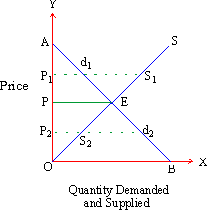|
2.5 The Concept of Equilibrium
Both demand and supply functions independently serve
important functions. However, it is important to bring them together in
an attempt to establish equilibrium. The concept of equilibrium,
though analytical in nature, is quite simple in practice. It can be defined
as a point of equality or agreement between buyers and sellers.
Since both demand and supply quantities are shown in the scheduled forms
these indicate mutual willingness of consumers and producers to purchase
or sell respectively, varying quantities at varying prices. The schedules
do not yet explain actual market price at which deals take place. This
can be possible only when the quantities demanded and supplied are exactly
equal at some uniform price. So long as this has not been achieved,
some buyers or sellers are yet dissatisfied and may attempt to raise or
lower the price. In this sense equilibrium is a point of complete
satisfaction of the given behavior of buying and selling and hence
an act of fulfillment of a given economic activity.
Letís present and illustrate the establishment of
equilibrium with the help of demand and supply functions in our earlier
examples (in the sections given above). We begin with two equations:
qd = 10 - 3P and qs = 2P
By definition, demand and supply must be equal (qd
= qs) for the condition of equilibrium.
qd = 10 - 3P = qs = 2 P or 10
- 3P = 2P
On solving this we find equilibrium price:

On substituting the value of price in demand and supply
function we get,
qd = 10 - 3P qd = 10 - 3 (2) = 10 - 6 = 4
qs = 2P qs = 2 (2) = 4
Hence equilibrium price is 2, at which
both quantity demanded and supplied are equal to 4. The algebraic
proof (Figure 7) of the equilibrium can also be presented geometrically.

Figure 9
In the figure, AB and OS are the
demand and supply curves respectively. The two curves intersect at point
E which is an equilibrium point at which price P = 2 and quantity
demanded and supplied are both equal (q = 4). At any other price
higher than P such as P1, the quantity supplied S1 exceeds
the quantity demanded d1 (S1 > d1) and hence
at this stage, some sellers remain dissatisfied. On the other hand at
any lower price such as P2, quantity demanded d2
exceeds quantity supplied S1 (d2 > S1) and this
time some buyers remain dissatisfied. Therefore only at the point of intersection
between demand and supply curves can equilibrium be
attained. In other words, equilibrium price represents that price at which
buyers are willing to buy the good and sellers are willing to sell it.
This is the point of satisfaction for both the groups.
**********
|